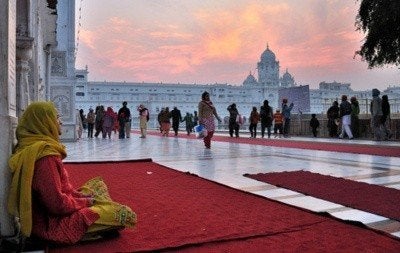
It is Monday morning and I am driving to work along a California freeway, listening to coverage about yesterday's mass shooting within the sacred spaces of the Gurdwara in Oak Creek, Wisconsin. In the car, my emotions have a moment to surface and finally catch up with me after a steady stream of television news reports all day yesterday and today.
On the car radio, a reporter talks about the congregation waiting outside of the Gurdwara. He described these Sikhs - the victims of the attack - reorganized themselves, setting up a kitchen and serving food and water to first responders and reporters. The reporter on the radio was amazed with this type of community response.
"The Sikhs believe that anyone, any stranger, who comes to their temple should be provided food and be welcomed. Even with all this going on, they still maintained this tradition." the steadfast dedication by those Sikhs - in the midst of such crisis and tragedy - to our faith's principles brought tears to my eyes.
It was only yesterday that I was randomly switching channels to watch my one of my favorite cable news shows, but was instead confronted with bold headlines sprawled across the screen: "WISCONSIN," "SIKH," "SHOOTING," "TEMPLE." It would take me a few moments to absorb. Innocent Sikh men, women and children were being attacked and killed by a now-alleged white supremacist. All indications were pointing in the direction of a hate-based crime. The nightmare of America's Sikhs - who have long suffered much of the brunt of post-9/11 backlash in discrimination, hate crimes and murder - was a reality unfolding before my eyes.
I remained glued to the television for the rest of the day, switching between cable news networks and social media platforms for the most up-to-date coverage I could find. Disbelief gave rise to grief, followed by frustration. I watched news anchors struggle in trying to report on a religious community they did not know. I saw Sikhs, stunned in the shock of this crime, unable to properly express to news reporters who we were as a people. Every question became an opportunity to hurriedly explain in too many words that we are not the enemy. Language barriers and a sense of urgency left reporters more confused.
As the evening went on, the media and the American Sikh community seemed to find a balance in which they could communicate with each other. A dialog was beginning to take hold. In the past, a picture of a turbaned man in the news was represented in a negative context. Here was the same media now engaging with a turbaned man in an entirely different context, trying to learn about a community they did not know and sharing in their pain. Getting a sense of what Sikhism is about, reporters even began to properly use Sikh terminology. Finally catching their breath after the day's tragedy, Sikh Americans were able to express themselves in a way that accurately represented their identity.
During that Sunday, we saw bridge being formed. The tragedies of this shooting occur at many levels. Of primary importance are the victims, survivors and the heroic police officers that risked their lives to stop this madman. They are in my prayers. On another level, it is also a tragedy that it took a mass murder to bring the Sikh community and their plight into the national discussion. This is where we find ourselves today.
It is today that we have initiated open dialog, and as we see the beginnings of our path, we must also seek to determine how we can best bring ourselves together to carry this conversation in the long term - and not just among Sikhs and non-Sikhs, but also among Americans of every community. We must continue to foster interfaith dialog and inter-community dialog if we wish to achieve the understanding we desire.
Like many times in our 500-plus years of history, Sikhs navigate through tragedy by maintaining high spirits and optimism. It is a state of mind we pray for when we conclude every service. It was in this spirit that the Sikhs of Oak Creek, Wisconsin, even as victims of an attack, saw to care for those who came to the Gurdwara to help.
It is also in this spirit that Sikhs will carry forward. We will continue tying our turbans and go out into the world. We will continue to go to our Gurdwaras, and we will continue to reach out to our neighbors. And, today, it there is an America that is reaching out to us in return. Together, we must ensure that our freedom to practice our faith in this country remains a proud symbol of America's values - one that no threat, domestic nor foreign - can shake.